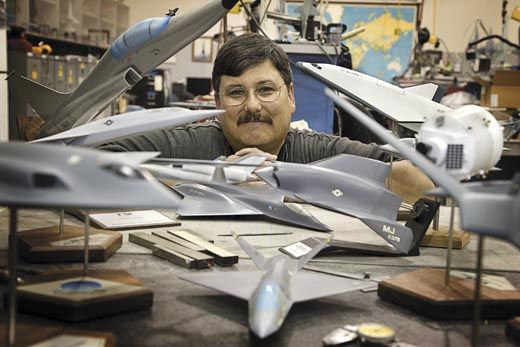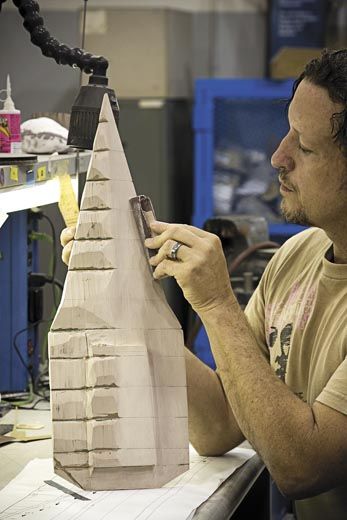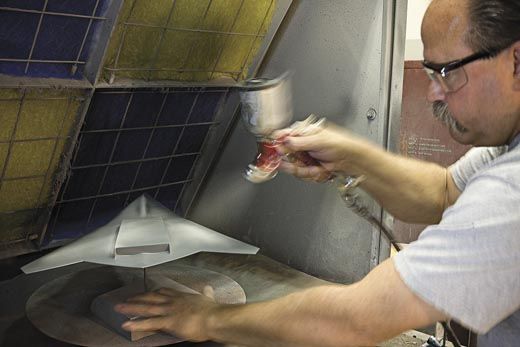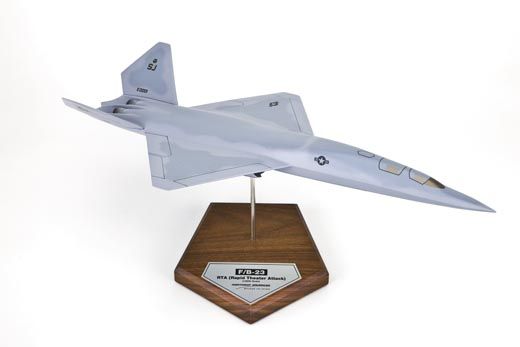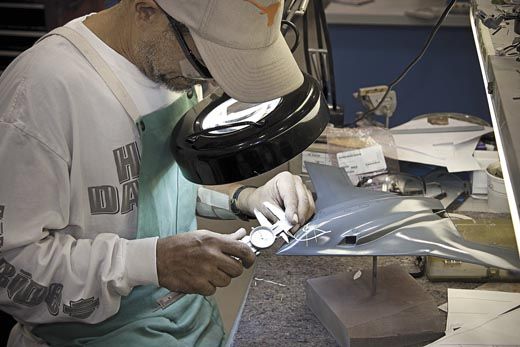Martial Arts
Memo to bad guys: Wanna know what U.S. warplanes you’ll tangle with in the future? Visit an aerospace model shop.
/https://tf-cmsv2-smithsonianmag-media.s3.amazonaws.com/filer/Future_Models_Flash_SEP09.jpg)
Shortly after 9 p.m. on a rainy February night in Los Angeles, Tony Chong switched on his home computer, logged into eBay, and began his nightly aircraft hunt. For more than two decades, Chong had been making exquisite aircraft models at Northrop Grumman’s display model shop—and collecting the rare desktop models his company and other U.S. airplane makers distributed to promote their programs. Often the listings on eBay were for castoffs, but that night in 2005 one model gave him a jolt: Painted in mottled camouflage and balanced on a familiar pentagon base, it was an 18-inch-long concept model of a Northrop Grumman FB-23 advanced bomber.
Chong recognized it immediately. It had come from his shop—and it was one of his company’s most closely guarded secrets. Somebody was punching a big hole into the black world of Northrop Grumman’s classified aircraft projects.
“Competitors could tell a lot from a model like that,” muses aviation historian Jay Miller. “It would tip them off that Northrop was determined to build on its YF-23 experience.” The YF-23 was Northrop Grumman’s entry in the Advanced Tactical Fighter competition, which Lockheed Martin won in 1991 with a design that became the F-22 Raptor. “[The bomber model has] bigger wings, a faired-in second crew station, redesigned intakes, revised fixed-geometry exhaust nozzles, an extended nose cone—this would have been a very viable candidate for an interim light bomber around 2015.”
In the secret world of advanced aircraft studies, concept models are the harbingers of combat aircraft that will be flying 20 years from now.
Paul Meyer oversees Northrop Grumman’s advanced aerospace programs, and it’s his job to see the future. “We look decades down the road, read studies, talk to think tank people in Washington,” says Meyer, who discusses future needs with people working at the Institute for Defense Analyses, RAND, and the Defense Advanced Research Projects Agency. “We look at what the world might look like, what the enemy might be considering—protecting the oil-rich Spratly Islands, or defending Antarctica from oil exploration. That begins to shape an environment that the vehicle needs to operate in.”
With the twin challenges of speed and stealth largely met—the F-22 can cruise at Mach 1 and above, and today’s frontline fighters have ultra-low observability—Northrop Grumman is betting that future military needs will center on smart, autonomous aircraft that can wait and listen—then fire when ready. “The issue today is persistent surveillance,” explains Meyer. “In the past, it was ‘I’ve got to get to the target fast.’ Now I want to get to the target and I want to stay there.”
“You want to anticipate the most stressing situation first and back off from that,” says Scott Winship, program manager for Northrop Grumman’s X-47B, an unmanned combat aircraft demonstrator to be flown from an aircraft carrier. “The most stressing situation is a denied area, so [the airplane] has to be stealthy. And if you want a global surveillance and attack system, with long range and long endurance, having a pilot in it is the limiting criterion.”
Anyone observing the trends in combat aircraft today can see that the future belongs to the pilotless. At least one industry insider predicted that direction 25 years ago. Famed Lockheed Skunk Works designer Kelly Johnson wrote in his 1985 autobiography that “with the price of fighter aircraft now running more than $30 million per plane with all the equipment, not including pilot costs, I can foresee the day when the fighter pilot will be on the ground, flying an unmanned fighter with a missile in it. With the latest electronic advances, I think this can be done remotely at a great saving in aircraft costs.”
Johnson would have known about the Model 235 drone built by Teledyne Ryan. In 1974, it set an endurance record, flying unrefueled for 28 hours. The company had hoped to win an Air Force contract, under a program called Compass Cope, for a high-altitude, remotely piloted vehicle to fly long-endurance photographic reconnaissance missions, but the program was canceled. Still, that legacy found its way in 1994 to the desk of configuration designer Alfredo Ramirez. Ryan Aeronautical knew the military was still looking for a pilotless surveillance aircraft, and company managers asked Ramirez to draw something up. “I knew the fundamentals,” Ramirez says. “Put sensors in the air, then relay the information they capture to satellites in real time and back down to the customer. Sensors need to look down, radar needs to scan an area, and the electro-optical unit has to see around any aircraft obstructions. So those needed to go on the belly. They talk to a satellite, so you need another dish on top of the aircraft.”
Ramirez began with a piece of graph paper. “I’m a doodler,” he says. “I drew some bubbles and some squares and a slab tail with two inputs, very similar to Compass Cope. Even though some designs are very radical, they’re usually an evolution. Take pieces from here, from there, and elsewhere, combine them, and it looks like a different plane but it has its genesis in many other things.”
The result would become the Global Hawk project, inherited (along with Ramirez) by Northrop Grumman when it bought Ryan in 1999. Pressed to explain his concepts, Ramirez often uses models. “Some people can visualize a lot quicker than others. When they can’t, with the model, you avoid all that translation.”
Scott Winship likes to use concept models when he’s vetting a design concept with potential customers and combat commanders. With the model, Winship says, he asks: “Does this make sense? Or are we screwing up? Are we just drinking our own bath water? Usually you get your head handed to you the first couple of times,” Winship says.
Again, it was Kelly Johnson who became famous for going to the potential users of his designs to research ideas. In the 1950s, he visited airfields to ask pilots flying North American F-86 Sabres in the Korean War what they wanted in their next fighter. Speed and altitude, they replied, and Johnson set out to design a jet fighter that would, he wrote, “fly higher and faster than anything flying anywhere. There was no formal requirement from the Air Force yet for such a plane.” But Johnson started designing anyway, sketching what would become the Mach 2-plus F-104 Starfighter. “Sometimes it’s awfully difficult to convince the customer of what we think he needs,” Johnson groused.
“Today we’re in a whole different era from that of Kelly Johnson,” says Skunk Works director of communications Dianne M. Knippel. “We rarely design a thing—whether unmanned or manned—to sell to a customer. But because we know we’ll continue to need new intel-reconnaissance technologies, we work on study contracts. We’re currently working on more than 500 program contracts because a customer has said, ‘What would you do to solve this problem?’ ”
At Lockheed Martin’s Advanced Program Center (and at other corporate and independent model shops), engineers use stereolithography, a process by which a computer program directs a laser to shape advanced polymers into valves, sensors, or other parts that are solutions to problems presented by a customer (see “Model Behavior,” Feb./Mar. 2007). “The computer program tells the thing to grow,” Knippel says. She adds: “We’re not just about airplanes anymore.”
And yet: Lockheed Martin also maintains a shop where artisans create concept models, once the process of design is past the “what if” stage.
Northrop Grumman’s model shop sits on a quiet corner of the sprawling Integrated Systems plant in El Segundo, California. The interior resembles a sculptor’s atelier—except that the traditional chisels, rasps, tin snips, and mallets share crowded workspace with computer monitors displaying templates for laser cutting. Models along the wall offer tantalizing glimpses into combat aviation’s future: an unmanned aerial vehicle with sawtooth edges, hypersonic spaceplanes, a needle-nose NASA concept, and an eerie surveillance drone called a “SensorCraft.”
These and other concept models find their way to trade shows, the Pentagon, DARPA, Congressional offices, and VIPs: When Soviet leader Mikhail Gorbachev visited Missouri’s Whiteman Air Force Base in July 1991 to sign the Strategic Arms Reduction Treaty, he was given a B-2 model with his name under the cockpit.
To make a new concept model for display, the shop staff follows a multi-step process that begins with assembling precise drawings and includes making the pattern, producing a mold, casting and finishing the blank—the shape of the model without markings or color—and mating it to a custom display stand. Chong assigns tasks based on each of his four-man crew’s unique skills: “Todd [Jameson] knows computer graphics and design, plus calligraphy. Jack has experience as a prototype mechanic. Manny has a sheet metal background, and Gary was a carpenter.” All are experienced craftsmen, using traditional hand tools and shop equipment to produce stealthy shapes with flowing curves.
“It’s not just cutting to the line,” notes Chong. “It’s knowing how lines will merge together and sweep, how to feel the shape and any imperfections. If you don’t have it in your fingers, you won’t be a good model maker. It’s not something you can teach.”
The results are beautiful, but they are expensive. A 1/48-scale display model typically requires 60 to 80 hours to produce, billed internally at a minimum of $60 an hour. For that money, Northrop Grumman buys fast turnaround and impeccable quality. When a company program manager is given 48 hours to be in Washington to defend a $100 million Air Force black project, a $4,000 design proposal suddenly seems reasonable.
Paul Meyer refers to a model of the company’s long-range supersonic strike concept, a huge tail-less arrowhead with two crew members. “It’s very Ferrari-looking,” he says. “The submerged inlets and cockpit tell you this airplane was designed for speed. You see the placement of the inlets and the exhaust tailored for [a low radar] signature and some significant speed ranges.” A “Ferrari-looking” model will do more than suggest speed. Like fashion models—beautiful, perfect, and high-priced—they help with a sale.
“I call it Chong’s Hierarchy of Visceral Impact,” Tony Chong says with a grin. “The more complex and tactile a presentation is, the greater the visceral impact will be on the viewer.” A drawing has more impact than words; a photo beats a drawing; a painting impresses more than a computer rendering; and a desktop model trumps them all.
Federal security clearances are not required to work in the shop, but all employees receive recurrent training designed to prevent proprietary information from leaking to competitors; the program they lose could be their own.
Program security is a sensitive matter with Chong, who has been with the company long enough to be considered its de facto historian. Pausing at an old cabinet, he pulls out a dusty, vaguely familiar model. It’s the eBay FB-23. Quick action by him and Northrop Grumman investigators had led to its recovery, and to the arrest of the thief, a facilities subcontractor whose job replacing sprinkler heads gave him a set of keys and trusted access. Chong reports that the thief was convicted, put on probation, and ordered to make restitution. He never did, and got some prison time.
The model shop got a new set of locks.
Contributing editor Chad Slattery photographs airplanes and collects vintage desktop aircraft models. His collection can be viewed at www.chadslattery.com/x.
